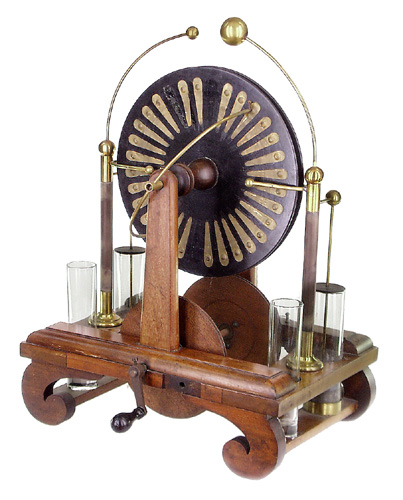A 7 foot machine built by Wimshurst Displayed at the Museum Science in Chicago Ill.
|
||
|
|
||
| figure39 there is added a collecting and discharging apparatus. This consists of two pairs of insulated combs, each pair having its spikes turned inwards toward the revolving disks, but not touching them; one pair being on the light, the other on the left, mounted each on an insulat- ing pillar of ebonite. These collectors are furnished with a pair of adjustable discharging knobs overhead; and sometimes a pair of Leyden jars is added, to prevent the sparks from passing until considerable quantities of charge have been collected. The processes that occur in this machine are best explained by aid of a diagram (Fig. 40), in which, for greater clearness, the two rotating plates are represented | ||
 |
||
| figure40 as though they were two cylinders of glass, rotating opposite ways, one inside the other. The inner cylinder will represent the front plate, the outer the back plate In Figs. 39 and 40 the front plate rotates right-handedly the back plate left-handedly. The neutralizing brushes n1 , n2, touch the front sectors, while n^, n, touch against the back sectors. | ||
| Now suppose any one of the back sectors represented near the top of the diagram to receive a slight positive charge. As it is moved on-ward toward the left it will come opposite the place -where one of the front sectors is moving past the brush n1 The result -will be that the sector so touched while under influence by n^ will acquire a slight negative charge, which it will carry onwards toward the right. When this negatively-charged front sector arrives at a point opposite n3 it acts inductively on the back sector which is being touched by n3 hence this back sector will in turn acquire a positive charge, which it will carry over to the left. In this way all the sectors will become more and more highly charged, the front sectors carrying over negative charges from left to right, and the back sectors carrying over positive charges from right to left. At the lower half of the diagram a similar but inverse set of operations will be taking place. For when n1 touches a front sector under the influence of a positive back sector, a repelled charge will travel along the diagonal conductor to n2 helping to charge positively the sector which it touches. The front sectors, as they pass from right to left (in the lower half), will carry positive charges, while the back sectors, after touching n4 will carry negative charges from left to right. The metal sectors then act both as carriers and as inductors. It is clear that there will be a continual carrying of positive charges toward the right, and of negative charges to the left. At these points, toward which the opposite kinds of charges travel, are. placed the collecting-combs communicating with the discharging knobs. The latter ought to be opened wide apart when starting the machine, and moved together after it has excited itself. In larger Wimshurst influence machines two, three, or more pairs of oppositely-rotating plates are mounted within a glass case to keep off the dust. If the neutral- izing brushes make good metallic contact these machines are all self-exciting in all weathers. Machines with only six or eight sectors on each plate give longer sparks, but less frequently than those that have a greater number. Mr. Wimshurst has designed many influence machines, from small ones with disks 2 inches across up to that at South Kensington, which has plates 7 feet in diameter. | ||
|
|



